Our expertise working with clients for the past three decades has taught us that great digital experiences are not built overnight. They rather require an iterative approach by which marketers can continuously measure customer engagement in a live environment and optimize experiences accordingly.

Image: Felipe Pelaquim
In this blog post, we want to give an overview of the tools and processes required to make the best digital experiences come to life in an enterprise environment.
How to build an engaging experience for your customers
Building and delivering an engaging customer experience is usually not something you get right on the first try. It requires a thorough understanding of your audience, their interests, expectations and needs through every step of the customer journey.
However, putting yourselves in your customers’ shoes is not just a saying. Consulting with customers during the design and/or testing phase might offer you a way to get to learn about your users and optimize their experience accordingly. This tactic might be well-suited when launching the first version of your digital experience. Constant shifts in customer expectations, market dynamics and technology make it so that a “set-and-forget” tactic is all but optimal.
A more suitable approach is based on the practice of Experience Optimization: continuously iterating on your digital products with the goal of enhancing the customer experience.
Experience Optimization boils down to 2 key processes: Experimentation and Personalization, where both complement each other very well.
Experience optimization in a nutshell
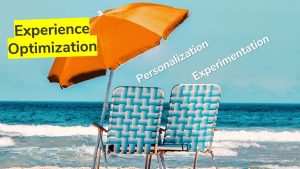
Experimentation is used to test different digital experiences with users and measure the effectiveness of these experiences. In practice, these usually take the form of an A/B test or a multivariate test (MVT). Measuring happens by setting a specific goal and tracking user behavior in analytics. A common goal used is the number of “conversions”, which can take several forms. In its most simple form, it could be a higher Click-Through Rate (CTR) on a certain Call-to-Action (CTA) button. However, conversion can also be seen broader, like for example the number of completed orders or the average order volume over time.
After these tests, a choice can be made about which of the tested experiences is the most effective (a.k.a. the “winning” experience), which is often the one picked to be put live for all customers. However, if analytics show that a certain experience resonates more with a specific customer segment, it might be decided to set up a personalization rule that serves the most-suited experience for that specific segment of customers. This test-driven approach is considered a best practice in Experience Optimization: first test, then personalize!
This is a basic example of Experience Optimization, however, In an enterprise environment, Experience Optimization requires a streamlined process in which different departments of the organization need to collaborate efficiently.
How to optimize customer experiences at scale
Scaling customer experience at larger organizations is often challenging. In such an environment, the volume of content, teams and customer data rapidly increases, fueling the need for a robust technology platform.
In the context of Experience Optimization, a platform that fulfils these needs encompasses 3 key elements:
- Content & assets: a central place to efficiently create, manage, design, and deliver all content and assets in your organization. Being a single source of truth, its goal is to minimize the impact of organizational silos on the optimization process.
- Data: measuring user behavior is essential to understand your customer during their journey and to follow up on experiments. Moreover, a record of all customer interactions (360° customer profile) is essential to enable meaningful personalization scenarios.
- Engine: to effectively run optimization scenarios, a robust optimization engine is crucial. It should allow non-technical teams to create experiments and personalization scenarios across all channels. To deal with large-scale experimentation and to enable real-time personalization, it should support teams with relevant AI capabilities.
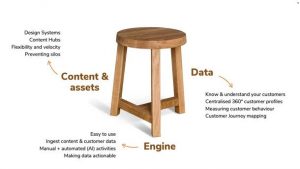
But, technology alone is not sufficient for running optimizations at scale. Processes and governance are equally important:
- Firstly, your optimization strategy should be aligned with your organization’s business objectives. To do this, clear goals and metrics should be defined to be able to measure the effectiveness of the initiatives taken.
- Secondly, omnichannel experiences should be considered a default. Optimizations should take into account customer interactions across a wide spectrum of touch points, both online and offline.
- Thirdly, Experience Optimization requires collaboration in cross-functional agile teams. It’s crucial to encompass any organizational silos that might exist and to work together towards one set of goals. This can also mean that experiences get launched sooner to be able to optimize them down the road, instead of taking too many assumptions about your audience during the design stage.
What technology is required to build and run great digital experiences?
When looking at technology, we see a clear evolution toward Digital Experience Platforms (DXP): well-integrated systems designed to streamline business and marketing operations.
At AmeXio, one of the technologies we use as the foundation for such a DXP is Adobe Experience Cloud (AEC). At its core, AEC consists of Adobe Experience Manager (AEM) as a Content Hub, Adobe Analytics and Adobe Target as an optimization engine.
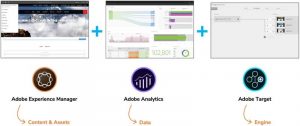
These tools are deeply integrated off-the-shelf, enabling the creation of optimizations from day 1, without the need to set up custom integrations.
As an optimization engine, Adobe acknowledges the synergies between Experimentation and Personalization in their Target offering: capabilities for both are foreseen and designed to be used together.
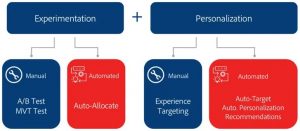
How to get started on experience optimization?
When establishing a culture of optimization at your organization, we recommend by starting off small. Here are our six rules of thumb:
- Although you should aspire to have an omnichannel optimization strategy, start with focusing on a single channel instead and run a few experiments in isolation. Achieving several small successes increases the chance that your endeavors find traction across your organization.
- Make sure to clearly define your efforts: outline precisely what problem you aim to solve and related hypotheses.
- Base yourself on facts: use behavioral data to identify potential areas for optimization.
- Start with the low-hanging fruits: where are users dropping out of the conversion funnel and why?
- To determine the effectiveness of your efforts, make sure to define a baseline before making any changes.
- Use KPIs as a measurement of success and review them regularly.
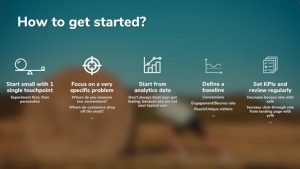

Connecting the dots,
from content to experience.
Want to know more? Discover our CXM solutions on the AmeXio Fuse minisite.





